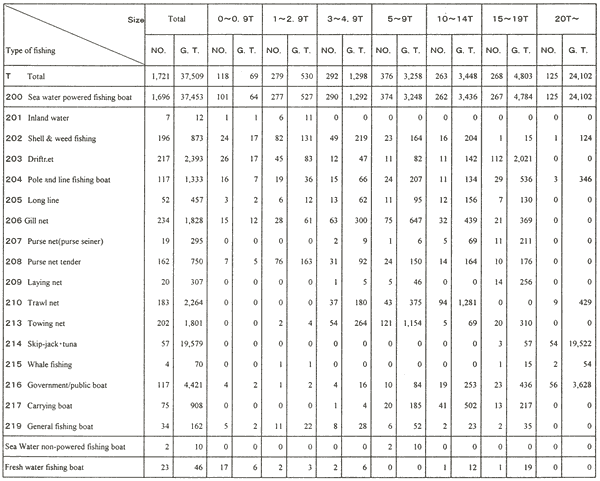|
7. Pleasure Boats
<Table 11>
Change in No. of Registered JCI Light Alloy Small Ships (AS of March 31)
| Year |
Pleasure
Motorboat
Pleasure fishing boat |
others |
Total |
Number of boat
increase/Year |
| Pleasure yacht |
Fishing boat |
Small pleasure&fishing boat |
(Others) |
(Subtotal) |
| 1989 |
2,797 |
16 |
50 |
114 |
541 |
721 |
3,518 |
--- |
| 1990 |
3,165 |
16 |
70 |
113 |
640 |
839 |
4,004 |
486 |
| 1991 |
3,502 |
17 |
83 |
121 |
739 |
960 |
4,480 |
476 |
| 1992 |
3,493 |
20 |
102 |
124 |
846 |
1,092 |
5,035 |
555 |
| 1993 |
4,396 |
19 |
114 |
127 |
1,108 |
1,368 |
5,764 |
729 |
| 1994 |
4,892 |
19 |
117 |
137 |
1,144 |
1,417 |
6,309 |
545 |
| 1995 |
5,653 |
22 |
139 |
155 |
1,233 |
1,549 |
7,202 |
893 |
| 1996 |
6,860 |
23 |
166 |
168 |
1,265 |
1,622 |
8,482 |
1,280 |
| 1997 |
8,707 |
23 |
194 |
184 |
1,336 |
1,737 |
10,444 |
1,962 |
| 1998 |
11,030 |
23 |
227 |
195 |
1,365 |
1,810 |
12,840 |
2,396 |
| 1999 |
13,987 |
21 |
245 |
198 |
1,412 |
1,876 |
15,863 |
3,023 |
| 2000 |
16,629 |
23 |
285 |
189 |
1,463 |
1,960 |
18,589 |
2,726 |
| 2001 |
18,534 |
23 |
310 |
186 |
1,543 |
2,062 |
20,596 |
2,007 |
| 2002 |
19,680 |
25 |
328 |
176 |
1,543 |
2,072 |
21,752 |
1,156 |
| 2003 |
19,970 |
24 |
346 |
191 |
1,552 |
2,113 |
22,083 |
331 |
|
References: (1) No. of ships registered for JCI test (As of March 31, 2003): 536,263
(2) No. of light alloy ships: 19,970 (3.7%)
Excerpted from: Light Metal welding VOL..36 (1998) NO. 123
Of the ships inspected by the Japan Craft Inspection Organization on March 31, 2003, there were 19,970 aluminum pleasure boats, which still account for only 3.7% of all pleasure boats. Most of these aluminum boats are also below 5 gross tons. In Japan no company had mass-produced aluminum pleasure boats until Toyota started this business recently.
8. Fishing Vessels
<Table 12>
LIGHT ALLOY VESSEL
Fishing Fleet by Type of Fishing (By Size of Vessel)
(Enlarged Image:66KB) |
 |
Fishing vessels in Japan continue to decline compared to the peak time when there were 450,000, some of the reasons for this include the establishment of the 200 nautical mile fisheries zone, enforcement of the fish catch control system, decrease in marine resources, and rapid increase in imported sea products.
Today, the number of fishery vessels has dropped to 350,000. Compared to FRP vessels, aluminum vessels are not growing mainly because of their high costs.
9. Aluminum Shipyard
There are about 60 aluminum shipyards in Japan. These include shipyards which mainly build aluminum vessels and shipyards which deal in both steel and FRP. Some of the major shipyards include Mitsubishi Heavy Industries, Mitsui Engineering & Shipbuilding, Universal Shipbuilding, Kawasaki Heavy Industries, and Ishikawajima-Harima Heavy Industries.
To expand the base of the aluminum shipyards around the country, the Cooperative Association of Japan Shipbuilders holds seminars on construction methods, welding techniques, and design methods in various locations. In 1980, as a project funded by the Nippon Foundation, we compiled the Handbook on Aluminum Alloy Ship Construction Technology (Construction Version) for use at our seminars, and as of today, we are still re-publishing it. We also compiled the Design Version in 1987, again with funds from the Nippon Foundation, and compiled the revised edition in 1996 with the aim of enhancing aluminum ship quality around the country. Both the Construction and Design versions are detailed, and at the same time easy to understand even to beginners. The Handbook should be very useful even in Thailand.
There are other technical references for high-speed vessels. With grants from the Nippon Foundation, the New High-Speed Vessel Engineering Handbook “Resistance and Propulsion Edition” was published in 2001, and the “Vessel Type and Performance Edition” in 2002 by the Ship & Ocean Foundation. We hope that these will also be useful references.
|